Understanding Weather Patterns for Kiteboarding in St. Augustine


Intro
For those who live and breathe kiteboarding, understanding the weather patterns can be as crucial as mastering the latest tricks in the air. In St. Augustine, a coastal paradise located in Florida, wind and water dynamics shift throughout the year, creating diverse riding conditions. While the allure of kiteboarding often draws enthusiasts to tackle the waves, knowing the intricacies of local weather can significantly elevate one’s experience.
Navigating St. Augustine requires kiteboarders to pay close attention to factors such as wind direction, temperature fluctuations, and the timing of seasonal shifts. This knowledge not only ensures safety on the water but also enables riders to optimize their time spent flying through the sky. Recognizing optimal conditions can mean the difference between a thrilling session and coming home disappointed.
In this guide, we will thoroughly assess the weather components that kiteboarders need to consider. This article will illuminate the crucial aspects of seasonal variations and how they impact riding. Whether you are planning your next adventure or just curious about the tides and gusts, having a detailed grasp of the weather will serve you well.
As we explore these themes, let’s dive into some equipment insights.
Equipment Insights
Having the right gear can greatly enhance your kiteboarding experience. But more than just a flashy kite or a flashy board, proper maintenance and understanding your tools can make all the difference.
Latest Gear Reviews
When it comes to kiteboarding, the market is full of options ranging from beginner-friendly kites to high-performance boards designed for experienced riders. Recently, brands like Duotone and Slingshot have introduced models that blend innovation with durability, catering to enthusiasts of all skill levels.
- Duotone Neo: Known for its stability and versatility in varying wind conditions, this kite is a solid addition for both novices and seasoned kiteboarders. It offers great retreat control, especially helpful for those learning.
- Slingshot Catalyst: This board is lightweight and provides excellent edge control, making it an ideal choice for those looking to improve their jumping techniques.
Essential Gear Maintenance
Every kiteboarder knows that gear doesn’t come cheap, so ensuring your equipment stays in top shape is paramount.
- Rinse your kite and board with fresh water after each session to prevent wear.
- Regularly check your lines for frays or knots—a weak line could mean disaster when you’re out on the water.
- Store your gear in a cool, dry place to avoid degradation from heat and humidity.
Keeping your gear well-maintained not only prolongs its lifespan but also enhances performance.
The Weather Dance: Winds and Tides
Diving into St. Augustine’s weather, we can’t ignore the significance of wind patterns. Here, wind direction, speed, and consistency dictate kiteboarding conditions. Whether you're facing the Atlantic or drawn towards the intra-coastal waterways, wind plays the conductor in this weather symphony.
Wind Patterns
- East/Northeast Winds: Typically dominate during the summer months. These winds bring consistent breezes ideal for steady riding.
- Northwest Winds: Often occur in the cooler months, offering more challenging conditions for experienced users.
"Understanding wind shifts can be the key to enjoying those epic sessions."
Temperature and Precipitation Trends
In St. Augustine, temperatures generally range from the mild 60s in winter to the sweltering mid-90s during summer. Notably, summer storms can pop up unexpectedly, which is why keeping an eye on local forecasts is wise.
- Optimal Riding Seasons: Generally, late spring through early fall provides the best conditions for kiteboarding in St. Augustine, balancing warm temperatures with favorable winds.
- Rainy Days: You can often expect rain from May to September, but don’t let that deter you. Winds may still allow for smooth sailing, provided the storms pass quickly.
In understanding St. Augustine's dynamic weather, kiteboarders can better prepare for their sessions and truly make the most of their time on the water.
Preamble to St. Augustine Weather
Weather in St. Augustine plays a pivotal role for kiteboarders, shaping not just the riding experience but also the safety measures one must take. The unique climatic features of this coastal town in Florida make it a popular spot for enthusiasts of all levels. Understanding the various weather elements—wind patterns, temperature fluctuations, and seasonal changes—could greatly enhance a kiteboarder's performance and enjoyment.
St. Augustine experiences a tropical climate characterized by warm temperatures year-round, but it’s not just the warmth that attracts kiteboarders. Wind speed and direction can drastically alter kiteboarding conditions. A gentle breeze one moment can shift into strong gusts the next, turning a fun day into a challenging one.
Kiteboarders need to be privy to local weather forecasts and trends. Why? Because the difference between smooth sailing and a rough tumble often hinges on a few crucial weather details. Imagine setting out on the water only to find the winds shifting unexpectedly—it's not a pleasant surprise for anyone. That's why entering the water with a solid understanding of the day's weather can be the difference between an exhilarating session and a regrettable one.
Additionally, seasonal weather impacts not only riding conditions but also planning kiteboarding events, gatherings, and even competitions. In spring, for instance, conditions become favorable for steady winds, making it a prime time for enthusiasts to take to the water. Meanwhile, summer might bring sweltering heat along with the threat of tropical storms, necessitating vigilance for safety.
Understanding the weather in St. Augustine isn't just a nicety; it’s a necessity for effective kiteboarding.
From wind patterns to precipitation levels, this article aims to equip kiteboarders—whether novice or veteran—with essential knowledge that will inform their decision-making process when planning sessions in St. Augustine. The interplay between the local weather conditions and the kiteboarding experience cannot be overstated, making this understanding a cornerstone of any kiteboarder's journey.
Climate Overview
Climate understanding is essential for kiteboarding enthusiasts in St. Augustine. The local climate sets the stage for when and how kiteboarders can enjoy the water. What’s more, a good grasp of climatic patterns not only helps kiteboarders plan their sessions but also enhances their overall experience on the water. With this knowledge, riders can avoid unfavorable conditions that might dampen their fun.
Tropical Climate Characteristics
St. Augustine's tropical climate is characterized by warm temperatures year-round, making it an appealing destination for kiteboarders. The average annual temperature hovers around 70°F (21°C), with summer months reaching peaks of 90°F (32°C) or more. This persistent warmth ensures that the waters remain inviting, allowing for kiteboarding throughout the year.
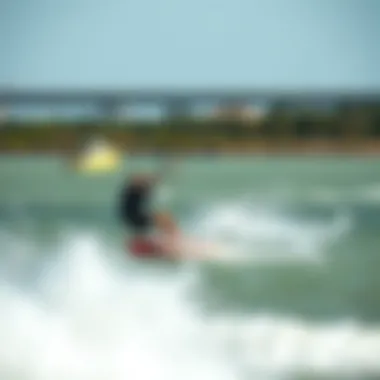
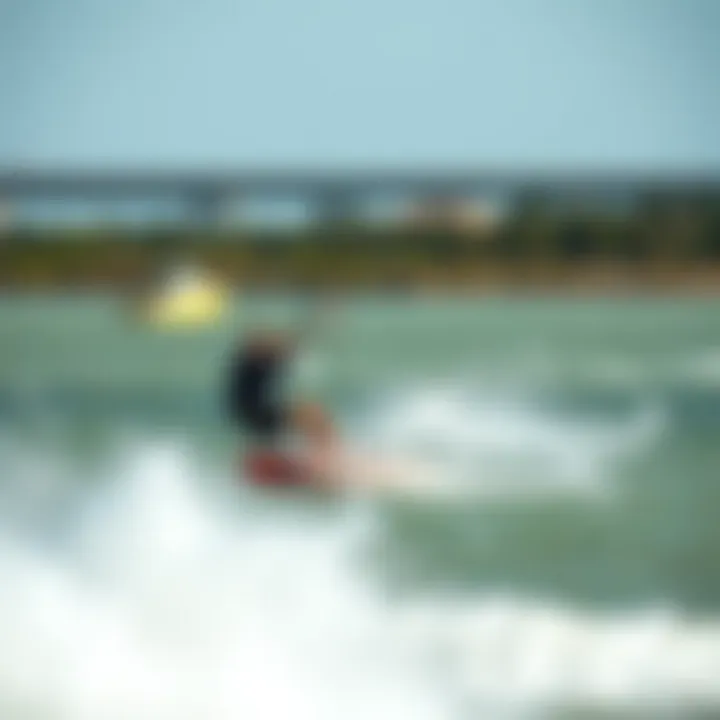
In addition to warmth, humidity plays a significant role in setting the pace. The region sees humidity levels hovering around 70-80%, particularly in the summer. This humidity can affect a rider's comfort level and their equipment. Wet gear can become cumbersome, leading to challenges while in action. In essence, while the warmth is tempting, the humidity must be kept in mind to ensure a satisfying session.
Annual Rainfall Patterns
When considering kiteboarding in St. Augustine, annual rainfall patterns also deserve attention. The area gets an average of 50 inches (127 cm) of rain each year, with most precipitation occurring in summer. These summer storms can sometimes roll in quickly, catching even the most seasoned kiteboarders off guard. It is advisable to keep an eye on local weather forecasts prior to heading out.
Breakdown of rainfall by month reveals interesting trends:
- May to September: This period typically sees heightened rainfalls, yet amidst these showers, some of the best wind conditions can exist.
- October to April: This timeframe offers drier weather but lower wind speeds, providing different challenges for kiteboarders.
"Understanding when to expect rain can be as vital as knowing wind patterns. It adds another layer to making savvy decisions about when to hit the water!"
In summary, a focus on climatic conditions, including temperature and rainfall trends, helps kiteboarders navigate their experiences. Keeping these elements in mind allows for better planning and preparation, crucial to having an enjoyable time on St. Augustine’s inviting waters.
Seasonal Weather Trends
Understanding a location's seasonal weather trends is vital for activities like kiteboarding, which is closely tied to specific weather conditions. In St. Augustine, the variation between seasons allows kiteboarders to gear their efforts, knowing what to expect, which can mean the difference between a day in the air or one on the shore. Let’s break down what each season brings and how it affects the overall kiteboarding experience.
Winter Weather Insights
Temperature Range
During the winter months, St. Augustine enjoys a relatively mild temperature range, typically hovering between 50 to 70 degrees Fahrenheit. This range is favorable for viewers who prefer moderate weather but perhaps not as thrilling for kiteboarding enthusiasts craving warmer conditions. The cooler temperatures can actually serve as a reprieve from the scorching heat of summer, allowing kiteboarders to engage in their sport without the usual fatigue that hot days bring. However, it’s crucial to note that the colder mornings could result in chilly water temperatures, so wearing a wet suit can significantly improve comfort.
Wind Conditions
Winter brings a unique wind pattern, where the breezes can be quite unpredictable. Strong northeasterly winds frequently sweep through the area, creating excellent conditions for kiteboarding enthusiasts. This wind direction tends to provide steady winds, which are essential for kiting. Nonetheless, kiteboarders should remain vigilant for sudden changes in wind strength and direction. Being prepared for gusts can mean the difference between a spectacular ride or a tricky landing.
Precipitation Levels
Regarding moisture, winter precipitation in St. Augustine is generally light, ranging from 2 to 4 inches per month. While this might not seem significant, the odd rainy day can be a buzzkill, especially when it occurs during prime kiteboarding hours. However, these rain showers are often short-lived, so seasoned kiteboarders can sometimes wait it out. Knowing these precipitation patterns helps kiteboarders plan appropriately, ensuring they make the most of dry, windy days.
Spring Conditions for Kiteboarding
Wind Reliability
As spring rolls in, St. Augustine sees an uptick in wind reliability, making it an ideal time for kiteboarding. Winds become more consistent, often ranging from 10 to 20 mph, which provides ideal conditions. This consistency allows kiteboarders to plan longer sessions without the fear of sudden calm spells that can end a day prematurely. It creates an environment where both novices and experts can fine-tune their skills.
Temperature Increase
With the arrival of spring, temperatures start creeping up, usually reaching the 70 to 80 degrees Fahrenheit range. While the rise in warmth is inviting and greatly enhances the kiteboarding experience, it also hints at increasing humidity levels. Kiteboarders need to keep hydration at the forefront, as warmer temperatures increase the risk of fatigue. Here, water becomes a kiteboarder's best friend, not just in terms of riding conditions but also for personal hydration.
Eventual Storm Patterns
Spring also introduces the potential for sudden storms, which can arise quickly, bringing heavy rains and winds. While these storms can create interesting conditions for thrill-seekers, safety must be prioritized. The unpredictability of these storms calls for keen observation of weather updates and readiness to either ride the waves or retreat to safety when needed.
Summer Heat and Its Implications
High Temperature Concerns
Summer in St. Augustine can be a scorcher, with temperatures often soaring above 90 degrees Fahrenheit. This intense heat can be a double-edged sword for kiteboarders. One must balance the need for summer fun with the risks posed by overheating and sunburns. Many kiteboarders take to the water in the cooler early morning hours or later in the evening to avoid the peak heat of the day.
Humidity Factors
Humidity during the summer can skyrocket, often exceeding 70%. This oppressive heat combined with high humidity can lead to discomfort while on the water or when assembling gear. Consequently, kiteboarders may find their performance hindered if they don't manage to cool off and remain hydrated. Choosing appropriate clothing and planning kiteboarding sessions around cooler times can help mitigate this challenge.
Tropical Storm Risks
Summer also marks the onset of the Atlantic hurricane season. St. Augustine is no stranger to the occasional tropical storm, and for kiteboarders, this presents a unique challenge. While the wind generated by such storms can be exhilarating, safety should always be a priority. Familiarity with storm patterns, evacuation protocols, and local warnings can ensure a safe experience when the weather turns unpredictable. Being aware of these risks isn’t just smart; it’s essential for anyone who wishes to stay safe while riding the waves.
Autumn Weather Dynamics
Transitioning Conditions
As autumn approaches, St. Augustine’s weather begins a gradual transition towards cooler, calmer conditions. This can be a welcoming shift for kiteboarders who prefer milder temperatures, usually in the 60s to 80s°F range. These conditions can also bring about a more stable wind pattern, ideal for kiteboarding, although some kiteboarders still might find themselves longing for the summer’s higher wind conditions.
Wind Shifts
Wind patterns start to shift, often providing a mix of breezy days alongside milder conditions. Experienced kiteboarders may find opportunities in these changes, as new wind directions can create fresh challenges. Taking the time to adapt techniques can turn shifting winds into an adventure rather than a struggle.
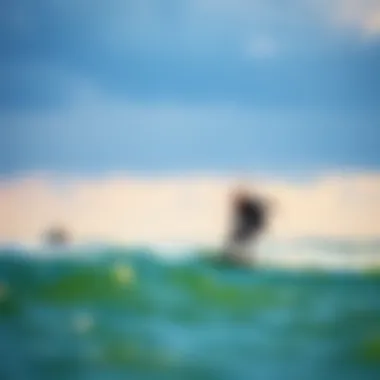
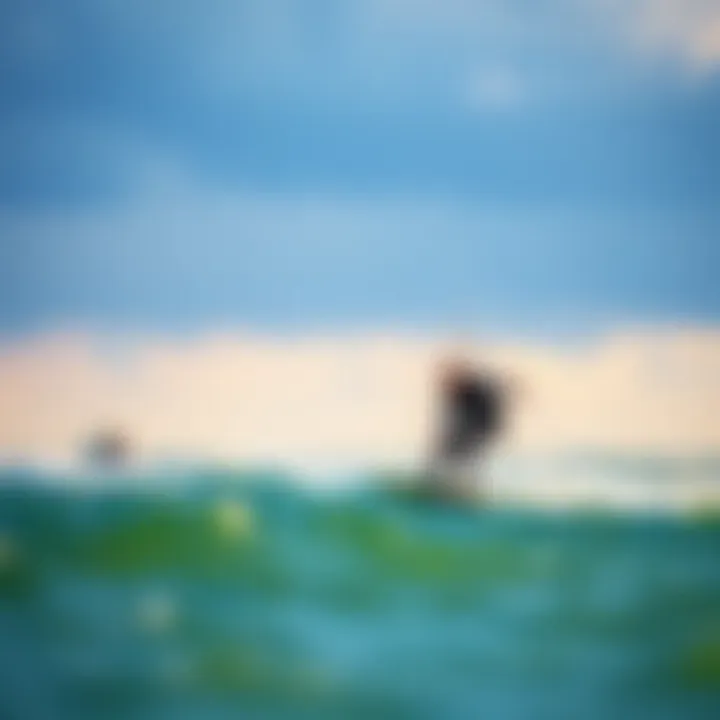
Hurricanes and Safety Precautions
During late summer and early autumn, hurricanes can pose a significant threat. Keeping an eye on weather forecasts and having a plan in case of emergencies is paramount. For kiteboarders, this not only means being prepared to stay off the water but also knowing which areas to avoid and how to respond effectively to changing conditions. Awareness can translate to safety, allowing the thrill-seeking adventure to remain safe.
Wind Patterns and Their Effects
Understanding the wind patterns in St. Augustine is like cracking the code to a hidden treasure for kiteboarders. The significance of wind cannot be overstated; it shapes the very conditions that make kiteboarding thrilling. It's not just about having a breeze; it's about having the right kind of breeze. Wind dictates when a kiteboarder can soar the skies or glide smoothly atop the water, making it a crucial element.
A solid grasp of wind dynamics can enhance performance, increase safety, and elevate the overall experience. Different wind conditions can turn a routine outing into an unforgettable adventure or a day best spent on land. Therefore, understanding these patterns is not just helpful, it’s essential.
Prevailing Winds
Prevailing winds act as the backbone of kiteboarding conditions in St. Augustine. These winds tend to blow predominantly from the east, influenced by the Atlantic Ocean's vastness. This consistent easterly breeze is a kiteboarder's best friend. It’s reliable and predictable, making it easier to plan sessions for both novice and experienced riders alike.
When these easterlies are complimented by the warm temperatures of the region, kiteboarding becomes a sport lovers' paradise. The wind aligns well with the natural layout of the coastline, enabling kiteboarders to take full advantage of the open waters. Importantly, knowledge of prevailing winds allows riders to anticipate possible hazards like sudden shifts in direction that could catch them by surprise.
Ideal Wind Speeds for Kiteboarding
Understanding Wind Speeds
When talking about kiteboarding, understanding wind speeds is crucial. Generally, wind speeds suited for kiteboarding lie between 12 to 25 knots. Too little wind, and the board won't glide; too much, and it could spell trouble. Knowing this range allows kiteboarders to make educated choices about when to hit the water, ensuring an enjoyable and thrilling outing.
The unique aspect of wind speed lies in its diversity—each kite size performs differently in a particular wind speed. For instance, larger kites excel in lighter winds, while smaller kites thrive in stronger gusts. This versatility means that a well-informed kiteboarder can adapt their gear, depending on the day's unpredictable weather.
Impact on Kiteboarding Techniques
Wind speeds can significantly impact kiteboarding techniques. For example, in lighter winds, a rider may need to use body movements and technique adjustments to maintain speed and control, while higher wind speeds may allow for more aggressive maneuvers, such as jumps or tricks.
In addition, understanding how wind speed correlates with the performance of your kite can lead to better execution and flow. The session becomes not just about riding, but mastering the art of reading the wind. It empowers kiteboarders, enhancing their skills and helping to avoid mishaps associated with misjudging wind conditions.
"Mastering the nuances of wind speeds allows kiteboarders to not only ride better but also to ride safer, transforming challenges into opportunities."
In short, wind patterns and speeds play a pivotal role in kiteboarding in St. Augustine. By understanding these elements, riders can maximize their performance and ensure a safe, memorable experience on the water.
Understanding Temperature Fluctuations
The relationship between temperature and kiteboarding in St. Augustine is pivotal. Understanding these fluctuations not only assists kiteboarders in planning their sessions but also augments their overall experience on the water. Temperature influences various factors—from water conditions to comfort levels. For kiteboarders, knowledge about temperature swings equips them to adapt plans accordingly, ensuring safety and maximizing enjoyment.
Daily Temperature Ranges
In St. Augustine, daily temperature ranges can vary significantly, particularly with the changing seasons. Generally, summer months can see temperatures rising into the high eighties during the day but cool off to the sixties by night. Conversely, winter can dip down to the forties or fifties overnight, while daytime highs might reach the sixties. This fluctuation is crucial for kiteboarders. A good strategy is to check daily forecasts to get a handle on how the temperature might shift; it could shape decisions around the best times to hit the water.
For example, kiteboarding during the warmer parts of the day—not just for heat’s sake, but also for wind conditions—can yield a better riding experience. This means capitalizing on the afternoon breezes when the temperature peaks, creating dynamic conditions ideal for kiteboarding.
Impact of Temperature on Water Conditions
Effects on Water Temperature
Water temperature plays a significant role in how pleasant, or challenging, kiteboarding sessions can be. In St. Augustine, the water ranges mostly from the mid-sixties in winter to the low eighties in summer. This variable can greatly influence not just comfort, but also the equipment choices needed.
One specific consideration is that warmer water can usually mean more stable wind conditions, making it a favorite among kiteboarders. However, exceedingly warm conditions might draw in thunderstorms, pushing riders back to shore. The ability to read these signs is of utmost importance, highlighting how crucial an understanding of water temperature is in planning outings.
Impact on Kiteboarding Comfort
Temperature not only affects water conditions but also impacts the comfort level of the kiteboarders themselves. Riding in overly chilly water without proper wetsuits can lead to discomfort or even hypothermia, especially during unexpected cold snaps. On the flip side, riding in excessively warm temperatures may induce fatigue and dehydration.
When the air temperature is in the seventies, kiteboarders can usually ride in comfort with light clothing. It’s imperative to stay hydrated and take breaks to avoid overheating—something that careful awareness of temperature can help prevent. Thus, understanding these temperature dynamics helps in preparing adequately, ensuring that nothing jeopardizes the ride.
The success of a kiteboarding session often hinges on the subtle nuances of temperature and its effects on both water and rider comfort.
Taking into consideration daily and monthly temperature expectations can not only enhance the kiteboarding experience but also ensure safety and longevity in the sport. Knowledge in this area is undeniably instrumental for anyone looking to enjoy kiteboarding in St. Augustine.
Precipitation and Its Influence
Precipitation plays a pivotal role in shaping the kiteboarding experience in St. Augustine. Understanding how it interacts with Kiteboarding conditions can provide a more nuanced perspective for enthusiasts considering their next session. After all, too much rain can lead to choppy waters, whereas a lack of it can dry up certain areas, affecting overall water quality. The key lies in monitoring rainfall patterns to map out when the conditions might align favorably for a ride.
Monthly Rainfall Averages
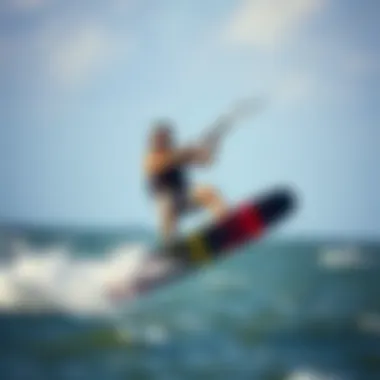
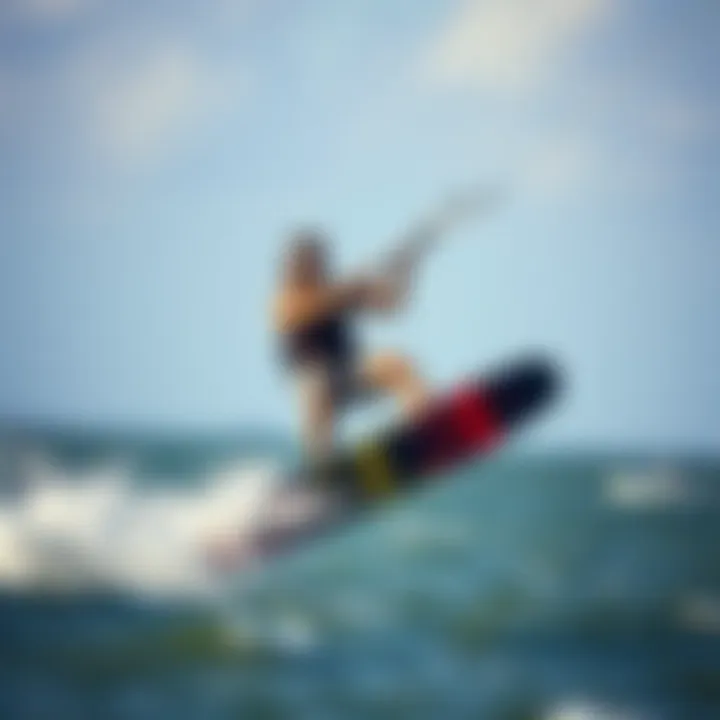
In St. Augustine, rainfall is not uniformly distributed throughout the year. Monthly averages reveal a fluctuation that kiteboarders should consider for planning purposes. For instance:
- January: 2.71 inches
- February: 2.71 inches
- March: 2.95 inches
- April: 2.58 inches
- May: 3.55 inches
- June: 6.74 inches
- July: 5.91 inches
- August: 6.91 inches
- September: 6.40 inches
- October: 3.19 inches
- November: 2.43 inches
- December: 2.89 inches
These averages show that the summer months, notably from June to August, experience significantly higher rainfall. Remember, heightened precipitation often correlates with increased humidity, making conditions feel hotter and impacting comfort levels while kiteboarding.
It would be wise to check forecasted rain before heading out. More rain can lead to more unpredictable conditions.
Storm Trends and Safety Measures
The weather in St. Augustine also brings seasonal storms that kiteboarders cannot afford to ignore. Ensuring safety should always be the priority, especially since storm patterns can shift from season to season.
Identifying Storm Patterns
Identifying storm patterns is crucial for kiteboarders wishing to navigate conditions safely. St. Augustine typically faces storm seasons during late spring through the summer. Characteristics of these storms include:
- Intense rain activity
- Strong winds that can change direction rapidly
- The possibility of thunderstorms
Recognizing these patterns can help makers or riders decide when to pack their gear away for inclement weather. Overall, knowing storm signs can avoid compromising safety.
Preparing for Inclement Weather
When it comes to kiteboarding, being prepared for inclement weather is a game changer. Proper preparation includes:
- Checking Forecasts: Use reliable weather sources like NOAA for real-time updates.
- Understanding Wind Changes: Recognize how the wind direction can shift due to approaching storms, which can impact your riding experience.
- Having Contingency Plans: Make sure to have your gear safely secured in case storms roll in quickly.
Preparation can make all the difference. It's not just about avoiding the rain; it's knowing how to read the signs of changing conditions and gearing up for them. A well-prepared kiteboarder can enjoy the sport while mitigating risks brought on by unexpected weather changes.
Optimal Weather Conditions for Kiteboarding
When it comes to kiteboarding in St. Augustine, understanding optimal weather conditions is not just a luxury; it's a necessity. Kiteboarders need to be a step ahead, knowing what makes or breaks a session on the water. The right combination of factors can enhance performance, safety, and overall enjoyment.
Defining Optimal Conditions
Wind Direction
Wind direction plays a pivotal role in kiteboarding success. A steady onshore wind, typically blowing from the ocean toward the land, creates the most favorable conditions for riders. If the wind comes from the southeast, it can often result in excellent, predictable patterns that allow for smooth navigation across the water.
On the flip side, if the wind shifts to an offshore direction, kiteboarders might find themselves at the mercy of unpredictable gusts, making the experience not so enjoyable. A common saying amongst local kiteboarders is, "Offshore is a no-go." This honestly reflects the hazards that come with such wind patterns that can quickly become risky.
In this context, understanding wind direction becomes essential for kiteboarders aiming to plan their outings effectively. Those in the know often look at the local wind charts or apps. Ideal conditions often hinge on wind coming in from the east or northeast, giving riders the best chance for stable sessions.
Temperature Preferences
When considering temperature preferences, kiteboarders must be aware of their personal comfort thresholds. St. Augustine can be warm, especially in the summer, with temperatures soaring. While some riders thrive in the heat, preferring to battle the waves in warmer water, others may find that cooler temperatures lead to a more enjoyable experience.
Temperatures in the range of 75°F to 85°F tend to be a sweet spot for most. This range allows for optimal performance and comfort without overexerting oneself in the sweltering heat. The lowest of the low should be meticulously noted; a chill can create an unpleasant experience, particularly when combined with wet gear. It's wise to keep an eye on the weather forecast and water conditions to choose a suitable time that aligns with personal preferences and comfort.
Precipitation Considerations
Precipitation isn't just a minor nuisance; it can drastically affect kiteboarding sessions. Rain can lead to a decrease in visibility, and while some might find a quick shower refreshing, frequent rain could indicate more serious weather systems. During the summer months, afternoon storms can develop rather quickly, often catching unwary kiteboarders off guard.
Riders should pay attention to weather alerts and familiarize themselves with seasonal rainfall patterns. A savvy kiteboarder always checks the radar. The general guideline is that light rain shouldn’t deter a determined spirit, but heavy downpours? Well, that’s another kettle of fish entirely. Here’s where a bit of local knowledge comes in handy.
"Knowing when to ride versus when to run for cover can be the difference between a fantastic day on the water and a regrettable experience."
Seasonal Comparison of Ideal Conditions
When one looks at seasonal variations, each month offers its share of strengths and weaknesses for kiteboarding. Summer months often bring consistent winds but also heat and potential thunderstorms. In contrast, autumn might provide milder temperatures but can also host unexpected hurricanes. Riding during spring offers a delightful balance between both extremes, while the winter months can chill the bones even as the wind patterns remain generally reliable. Understanding these variations allows kiteboarders to tailor their outings effectively, ensuring that every trip is as enjoyable and safe as possible.
By keeping an eye on these vital factors—wind direction, temperature, and precipitation—kiteboarders can optimize their enjoyment and safety on the water. Staying informed and prepared translates to better rides and memorable experiences in the diverse climate of St. Augustine.
End: Weather and Kiteboarding Synergy
As we wrap up our exploration of St. Augustine's weather and its distinct influence on kiteboarding, it's paramount to underscore the interconnection between these unique elements. Kiteboarders must navigate not just the thrill of gliding across the water but the intricate dance of wind, temperature, and seasonal shifts that define the experience.
Understanding the synergy between weather and kiteboarding can significantly impact one's enjoyment and safety on the water. The local climate, characterized by its warm tropical essence and diverse annual weather patterns, sets the stage for thrilling kiteboarding opportunities. From the mild breezes of spring, which coax the kiteboarder into action, to autumnal winds that can pack a punch, each season offers a different flair to the sport.
There are several specific elements that kiteboarders should keep in mind when considering the weather conditions:
- Wind Direction: Knowing the wind's behavior, including the prevailing patterns, is central to planning a successful kiteboarding outing. The right direction can be a game-changer for a smooth ride.
- Temperature Preferences: As simple as it sounds, being aware of the ideal temperature blends comfort with performance. Too hot or too cold can make a world of difference.
- Precipitation Considerations: Rain might be a nuisance on land, but its impact on water conditions can't be overlooked. Flooded areas or rough seas can pose challenges.
By fusing this knowledge with practical experience, kiteboarders can refine their approach, ensuring they ride in optimal conditions. As the weather is always changing, staying updated with accurate forecasts becomes essential. Reliable sources, such as NOAA and local forecast services, help in making informed decisions.
Ultimately, this synergy between understanding weather patterns and kiteboarding techniques not only enhances performance but safeguards enthusiasts against unforeseen conditions. A kiteboarder's journey is as much about conquering the winds as it is about learning the subtleties of nature. Thus, embracing this knowledge allows kiteboarders to harmonize their passion with the forces of nature, ensuring a thrilling yet safe adventure on the waters of St. Augustine.







